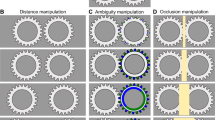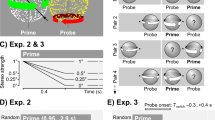Abstract.
A neural network which models multistable perception is presented. The network consists of sensor and inner neurons. The dynamics is established by a stochastic neuronal dynamics, a formal Hebb-type coupling dynamics and a resource mechanism that corresponds to saturation effects in perception. From this a system of coupled differential equations is derived and analyzed. Single stimuli are bound to exactly one percept, even in ambiguous situations where multistability occurs. The network exhibits discontinuous as well as continuous phase transitions and models various empirical findings, including the percepts of succession, alternative motion and simultaneity; the percept of oscillation is explained by oscillating percepts at a continuous phase transition.
Similar content being viewed by others
Author information
Authors and Affiliations
Additional information
Received: 13 September 1995 / Accepted: 3 June 1996
Rights and permissions
About this article
Cite this article
Carmesin, HO., Arndt, S. A neural network model for stroboscopic alternative motion . Biol Cybern 75, 239–251 (1996). https://doi.org/10.1007/s004220050291
Issue Date:
DOI: https://doi.org/10.1007/s004220050291




